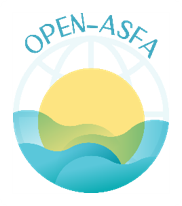Gracilaria bursa-pastoris of Bizerte lagoon (North of Tunisia): a spatio –temporal study of some hydro biological parameters, agar yield and quality
DOI:
https://doi.org/10.71754/instm.bulletin.v44.462Keywords:
Potential resources, Parameters, Phosphorus, Weight, Gametophytes, Agar, Dry weight, Dissolved oxygen, Salinity, Temperature, Seaweeds, Biomass, Environmental factors, Seasons, Quality, Summer, Spring, pH, Gels, Seasonal variation, Yields, Industry, Marine, Gracilaria bursa-pastoris, MED, Tunisia, Bizerte, Bizerte lagoonAbstract
In Tunisia, seaweed eco-biological and valorization studies are relatively recent. In this context, the red seaweed Gracilaria bursa-pastoris has been studied during a year at three different locations in the Bizerte Lagoon (North of Tunisia): Menzel Jemil (MJ), Menzel Abderrahmane (MA) and Menzel Bourguiba (MB). Environmental parameters such as temperature, salinity and nutrients were measured. The weight, length, number of ramifications at 0.5 cm from the apices in gametophyte and terasporophyte thalli and biomass were investigated. Besides, the seasonal variation of the agar yield and quality was studied. Results showed seasonal and temporal fluctuations of all parameters studied. Thus, the maximum of temperature (32.2 °C) was measured in August at MB. The salinity ranged from 33 psu in April at MA to 41.2 psu at MB in November. The pH varied from 8 to 8.8. The dissolved oxygen reached 11.2 mg L-1 at MJ in October. The nitrogen and the phosphorus elements varied also during the study period according to the season and the sampling site. The maximum weight of Gracilaria bursa pastoris occurred in summer (134.58g) in the tetrasporophyte thalli at MJ. The highest length was recorded in January (30.5 cm) in tetrasporophytes at MB. The maximum ramification number occurred in April (54) in mature females (cystocarpic thalli) at MA. The highest biomass was obtained in summer (56.23 g m-2 dry weight) at MJ. The maximum agar yield (27.48 %) was obtained in spring at MJ. The highest gel strength, gelling and melting temperatures were also recorded in spring (148.33 g cm-2, 40.16 °C and 83 °C, respectively). All of the results indicated that Gracilaria bursa-pastoris may be considered as a potential resource for agar industry in Tunisia. This hydrocolloid (agar) may be used in different fields, namely in food and cosmetic industries.












